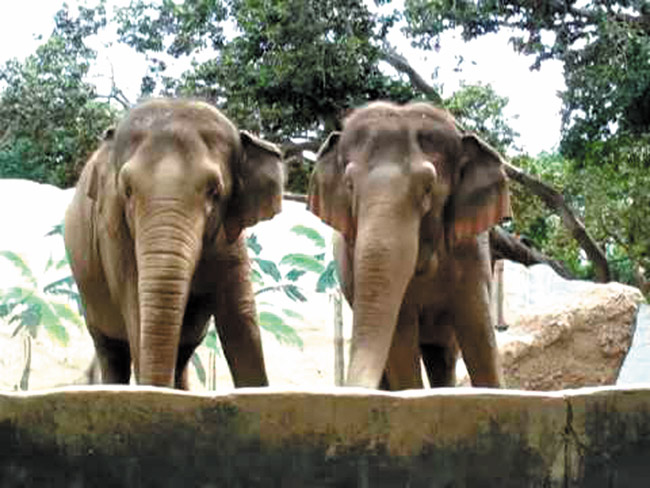Health Problems Of Zoo Elephants
There are about 290 elephants living in zoo captivity in the U.S. – two of them here. We’ve had nine over the years at our city-operated Honolulu Zoo. Five died. Two were relocated.
People for the Ethical Treatment of Animals (PETA) claims the up to 15,000-pound pachyderms suffer chronic ailments, emotional trauma and premature death in zoos. A Seattle Times probe found that the infant mortality rate in captivity is triple that in the wild.
So zoos have been increasingly under fire for their elephant exhibits.
Now we have a new, three-year, $800,000 study on elephant welfare in zoos through a federal grant administered by Kathy Carlstead, director of research and conservation at Honolulu Zoo. The 27-member team included zoo professionals and faculty members from three universities. They went through medical records, 2,500 hours of elephant-in-zoo videos and fecal samples from 40,000 pounds of elephant dung.
The report is mainly a “how to keep elephants healthy” handbook and doesn’t address the largely emotional issue of captivity of these big and beloved animals. Nor does it point fingers at any specific zoos.
It does refute claims of frequent elephant foot problems at zoos. The majority has none. But it agrees that concrete or stone enclosures create more foot issues.
And the more exercise, the better the creatures’ body conditions. The study recommends more frequent meals throughout the day and unpredictable timing of those meals.
We’ve all seen zoo elephants standing and swaying. They seem bored. The study says they need bigger spaces, more interaction with zoo staff, a choice of staying outdoors overnight and some time spent with younger elephants.
But the anti-captivity clamor continues.
That Seattle Times probe went on to say: “Publicly, the zoo industry continues to claim today that elephants are thriving inside zoos. It’s a message that the Association of Zoos and Aquariums has delivered repeatedly to lawmakers and regulators, trumpeted in news releases and highlighted in a recent national marketing campaign. But they know it’s not true. And it never has been.
“Rather, the decades-long effort by zoos to preserve and protect elephants is failing, exacerbated by substandard conditions and denial of mounting scientific evidence that most elephants do not thrive in captivity.”
Elephants historically were kept for display in Egypt, China, Greece and Rome. The Romans pitted them against humans and other animals in gladiator events.
C’mon, guys! Won’t somebody at the top recognize that University of Hawaii isn’t up to NCAA Division I FBS football? We don’t have the recruits or the money to play with the big boys.
Yes, there was a time (1924-25) of two undefeated seasons under coach Otto Klum, and we even beat Colorado, Colorado State and Washington. But they were small-time programs.
Then, in 1961, UH Board of Athletic Control abolished the football program because of its debt. It was restored a year later.
I wouldn’t kill it. I’d certainly downgrade it.






